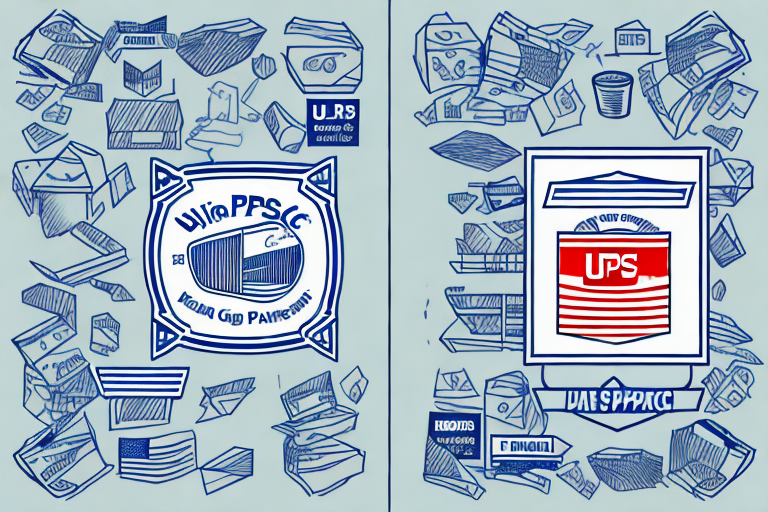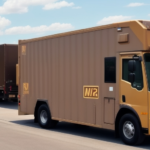Comparing USPS Shipping Rates vs UPS Shipping Rates
If you're a business owner in need of reliable and affordable shipping options, you've probably considered both USPS and UPS as potential carriers. But how do the two compare when it comes to rates and services? In this article, we'll explore the factors that can help you make an informed decision between these two giants in the shipping industry.
Factors to Consider When Choosing Between USPS and UPS Shipping Rates
When choosing between USPS and UPS shipping rates, several key factors should be taken into consideration:
- Package Size and Weight: USPS tends to be more cost-effective for lighter items, while UPS may be better suited for larger or heavier packages.
- Shipping Destination: Compare domestic and international rates and delivery times for both carriers to ensure they meet your needs.
- Shipping Services Offered: USPS is known for its Priority Mail and flat-rate options, whereas UPS offers a variety of delivery speeds and comprehensive tracking features.
- Customer Service: UPS often provides more personalized customer service and robust online tools for managing shipments, which can be beneficial for businesses with high shipping volumes.
For detailed insights, refer to the UPS shipping rates guide.
Which Shipping Carrier Is More Cost-Effective: USPS or UPS?
Determining cost-effectiveness between USPS and UPS requires a thorough analysis of your business's specific needs. According to the UPS Shipper Research, USPS may be more economical for smaller, domestic packages, while UPS offers competitive rates for larger or international shipments with added benefits like enhanced tracking and insurance.
Additionally, consider the speed of delivery. UPS generally provides faster delivery times for both domestic and international shipments, which might justify the higher cost for businesses that prioritize quick delivery.
Businesses that ship frequently or in large volumes can benefit from discounts offered by both carriers. It's advisable to inquire about these discounts to optimize your shipping budget.
The Pros and Cons of Using USPS Shipping Rates for Your Business
Using USPS for your shipping needs comes with several advantages:
- Diverse Shipping Options: Including flat-rate boxes and envelopes that cater to various budgets and delivery timelines.
- Delivery to PO Boxes and Military Addresses: Expanding your reach to customers with these specific address types.
- Competitive International Rates: Affordable shipping to over 190 countries, ideal for businesses with a global customer base.
- Sustainability Initiatives: Eco-friendly options like Priority Mail Express use environmentally responsible packaging materials.
However, there are some drawbacks to consider:
- Limited for Large/Heavy Packages: USPS may not be the best option for oversized or heavy shipments.
- Tracking Limitations: Their tracking and delivery confirmation features might not be as comprehensive as UPS.
- Customer Support: USPS offers online support and a customer service hotline, but getting prompt assistance can sometimes be challenging.
Understanding the Differences in Shipping Speeds Between USPS and UPS
Delivery speed is a crucial factor in choosing a shipping carrier. USPS offers various shipping speeds, including:
- Priority Mail Express: Overnight to 2-day delivery.
- Priority Mail: 1-3 business days.
- First-Class Mail: 1-5 business days for lightweight packages.
In contrast, UPS provides delivery speeds such as:
- UPS Next Day Air: Guaranteed next-business-day delivery.
- UPS 2nd Day Air: Delivery within two business days.
- UPS Ground: 1-5 business days.
Generally, UPS offers faster delivery times compared to USPS, which can be a significant factor if speed is paramount for your business operations.
How to Calculate Shipping Costs with USPS and UPS Rates
Both USPS and UPS provide online shipping calculators to estimate costs based on package size, weight, and destination. However, shipping costs can vary significantly depending on the chosen services. For instance:
- Additional Features: Services like extra tracking or delivery confirmation will increase the cost.
- Insurance: Adding insurance for high-value items will also add to the shipping expense.
For accurate pricing, use the UPS shipping calculator or the USPS Price Calculator.
Tips for Saving Money on Shipping Costs with USPS or UPS
Here are some strategies to reduce shipping expenses with both carriers:
- Choose the Right Shipping Service: Select a service that aligns with your package's size, weight, and delivery timeline.
- Use Flat-Rate Options: These can be more economical for heavier or bulkier items.
- Purchase Shipping Supplies in Bulk: Buying boxes and envelopes in bulk can lead to significant savings over time.
- Compare Rates: Regularly compare shipping rates from both USPS and UPS to ensure you’re getting the best deal.
How to Track Your Packages with USPS and UPS
Both USPS and UPS offer robust tracking systems:
- USPS Tracking: Enter your tracking number on the USPS website or mobile app to monitor your package’s journey.
- UPS Tracking: Use the UPS website or mobile app for detailed updates, including real-time delivery status and confirmation signatures.
For enhanced tracking features, UPS provides real-time updates and delivery confirmations, which can be particularly useful for high-value shipments.
Comparing International Shipping Rates: USPS vs. UPS
When shipping internationally, both USPS and UPS offer multiple options, but rates and services differ:
- USPS: Services include Global Express Guaranteed, Priority Mail International, and First-Class Package International Service.
- UPS: Offers services like UPS Worldwide Express, UPS Worldwide Express Plus, and UPS Worldwide Expedited.
Your choice will depend on factors such as delivery speed, package value, and destination. UPS generally provides faster and more comprehensive international services, while USPS can offer more economical rates for standard shipments.
Customer Service Comparison: USPS vs. UPS
Effective customer service is essential for resolving shipping issues promptly:
- USPS: Offers customer support via phone, email, and online chat. Their contact options include an extensive online help center with FAQs.
- UPS: Provides customer service through phone, email, and live chat on their website. Additionally, UPS offers an extensive resource library for troubleshooting and support.
While both carriers offer multiple support channels, UPS is often praised for its more responsive and personalized customer service.
How to Choose the Right Shipping Method for Your Business Needs
Selecting the appropriate shipping carrier involves evaluating your unique business requirements:
- Package Size and Weight: Determine which carrier offers better rates and services for your typical package dimensions and weights.
- Shipping Destination: Consider whether you ship domestically, internationally, or both, and choose a carrier that excels in those regions.
- Delivery Speed: Decide if fast delivery is a priority or if cost savings are more important.
- Tracking and Security: Assess the tracking features and security options provided by each carrier.
Ultimately, conducting a comprehensive comparison of rates, services, and additional features will help you make an informed decision that aligns with your business goals.
Best Practices for Packaging Your Products for Shipment with USPS or UPS
Proper packaging ensures that your products arrive safely and intact. Here are some best practices:
- Use Sturdy, Corrugated Boxes: Protect your products from damage during transit.
- Wrap Fragile Items: Utilize bubble wrap or other protective materials to safeguard delicate products.
- Cushioning Materials: Employ foam peanuts or air-filled packaging to prevent items from shifting inside the box.
- Secure Sealing: Use high-quality packing tape to ensure boxes remain closed throughout shipping.
The Impact of Peak Season on Shipping Rates with USPS and UPS
Peak shipping seasons, typically from November to January, can significantly affect shipping rates:
- Surcharges and Increased Rates: Both USPS and UPS may impose additional fees during high-demand periods.
- Increased Shipping Volume: Higher volumes can lead to delays, so plan accordingly to avoid customer dissatisfaction.
To minimize costs during peak seasons:
- Plan Ahead: Ship earlier in the season to take advantage of regular rates.
- Compare Carrier Rates: Regularly check rates from both USPS and UPS to identify the most cost-effective options.
Case Study: A Comparison of Actual Shipping Costs with USPS and UPS
To illustrate the cost-effectiveness of USPS vs. UPS shipping rates, consider the following case study:
Business A needs to ship a 10-pound package from New York to Los Angeles using standard ground shipping. The cost of shipping with USPS is $20, while shipping with UPS is $35. In this scenario, USPS is the more cost-effective option for Business A.
Business B requires shipping a 100-pound package internationally. Due to UPS's competitive rates for heavier shipments and advanced tracking features, UPS may be the more economical choice for Business B.
This example underscores the importance of evaluating your specific shipping requirements to determine the most cost-effective carrier.
Future Trends in the Shipping Industry: Implications for USPS and UPS
The shipping industry is rapidly evolving, driven by technological advancements and changing consumer behaviors. Key trends include:
- Rise of E-Commerce: As online sales continue to surge, the demand for reliable and affordable shipping options increases.
- Automation and Technology: Innovations like automated sorting and AI-driven logistics can enhance efficiency and reduce costs.
- Sustainability: Growing environmental concerns are pushing carriers to adopt eco-friendly practices and packaging.
Both USPS and UPS must adapt to these trends to remain competitive. For example, expanding their e-commerce solutions and investing in sustainable technologies will be crucial for future growth.
Conclusion
When comparing USPS vs. UPS shipping rates and services, it's essential to assess your business's specific needs and shipping requirements. Both carriers offer a variety of options, ranging from affordable standard shipping to expedited delivery with advanced tracking features.
To choose the best option for your business:
- Consider package size and weight.
- Evaluate shipping destinations.
- Assess delivery speed and tracking needs.
- Compare rates and explore ways to save, such as bulk purchasing or utilizing flat-rate options.
By carefully analyzing your shipping needs and leveraging the strengths of each carrier, you can make informed decisions that ensure your packages arrive on time and in excellent condition.






















